Denis Avey: The Man Who Would Be Righteous
In 1995, Ernst Lobethal gave his testimony as a survivor of The Holocaust to the Survivors of the Shoah Foundation for their video library, as thousands of others have done. In it, he had some words to say about a British soldier he met while interned at Auschwitz III (Monowitz) who had done him a favor.
Lobethal records that the soldier he called Ginger “gave me a letter and 10 packs of cigarettes, and a bar of chocolate from my sister. Ten packs of English cigarettes – it’s like being given Rockefeller Center.” He also said, “I had heavy soles put on my boots for two packs of Players cigarettes (pause) and that, later on, came again to save my life on the death marches that took place in 1945.” This clip from the video was shown on the BBC Online News Magazine on November 29, 2009.(1) The article says that
Mr Lobethall traded two packs of Players cigarettes in return for getting his shoes resoled. It helped save his life when thousands perished or were murdered on the notorious death marches out of the camps in winter in 1945.
Lobethal’s testimony was at some point taken under consideration by the “Yad Vashem Memorial Museum’s Commission for the Designation of the Righteous,” a rather pompously-named committee, headed since 2005 by Israel Supreme Court Justice Jacob Tuerkel, that examines candidates before bestowing upon them the equally grandiose title of ‘Righteous Among the Nations.’
Yad Vashem, Israel’s official institution for Holocaust research and propaganda, set up this commission in 1963 with the intent, according to their website, to single out within the nations of perpetrators, collaborators and bystanders, persons who bucked the general trend and helped the persecuted Jews. (my italics)
As I understand this, to Yad Vashem—the highest Holocaust authority for not only Israel’s Jews but all Jews—every country that had ‘perpetrators’ and ‘bystanders’ are included in the Nations. Thus, only Israel, which did not exist at the time, is separate, or above the Nations (something I will get back to later).
According to the website, this Commission for the Designation of the Righteous is made up of volunteers, most of them holocaust survivors, each of whom are ‘expert’ in the history of the Holocaust in a certain region of Europe. They receive cases for evaluation and present their recommendations to the Commission to discuss.(2) Then the final decision is made by the Chairman, always a Supreme Court Justice. The righteous are defined as non-Jews who risked their lives to save a Jew or Jews during the Holocaust. Yad Vashem has now given over 22,000 people this title. They come mainly from the greater European area, but with several from beyond, such as from Chile, Japan, Vietnam and the USA.
Currently there are six who did their righteous duty at Auschwitz; Denis Avey will apparently be the seventh. Thus, we want to look into Mr. Avey’s conduct at the Auschwitz camp and how he saved the life of a Jew to find what the standards for this award really are.
* * * * *
Denis Avey came into the picture because Ernst Lobethal, a German Jew originally from Breslau, in his testimony referred to above remembered a British soldier who had befriended him—whom he called Ginger (apparently because of his red hair). He said this soldier had managed to send a letter to Lobethal’s sister in England asking her to send him cigarettes and other items that he, Avey, would be able to get to her brother Ernst. He said she sent 10 packs of Player’s cigarettes, a bar of chocolate and a letter, which Mr. Avey smuggled to Lobethal.
Lobethal claimed in his ‘Survivors of the Shoah’ interview that trading the cigarettes enabled him to have his boots resoled, which saved his life on the death march later on when Auschwitz was abandoned. A Times article says Lobethall purchased boots and also scraps of food, which helped him to survive the death march.
Apparently, Yad Vashem searched among the British POW’s, with the help of the BBC (British Broadcasting Corporation) (3), and came upon Denis Avey. At this point, the details are unclear. Did the BBC approach Avey? Did Avey just spontaneously begin telling his story at this time? Nothing is said of this in any of the three UK news articles. It’s only said that Avey opened up and told his incredible story after 65 years of silence only last October, when he was also reunited with Lobethal’s sister Susanna Timms, 86, after she was traced to Solihull, West Midlands. The result is that Yad Vashem had another candidate for their ‘Righteous Among the Nations’ award.
Here is what Yad Vashem says:
For obvious reasons this honour cannot be based on Avey’s word alone, says Susan Weisberg, spokeswoman for Yad Vashem. Each case must be substantiated by eyewitness testimonies and archival documents of the period.
This process is now ongoing, so let’s look at the news articles about Denis Avey and see if there are eyewitnesses and archival documents.
* * * *
The prestigious Times did their own tribute to Denis Avey in a Feb. 25, 2010 article(4), written by Jacob Wallis Simons. Some of the details change and one has to wonder whether it’s the writer Simons, the Times staff, or Avey himself who made the changes from the BBC version. It begins with a description of Avey as a formidable figure, even at the age of 91. “More than 6 ft. tall, with a severe short back and sides (a hair cut description) and a piercing glare, he combines the panache of Errol Flynn with the dignity of age.”
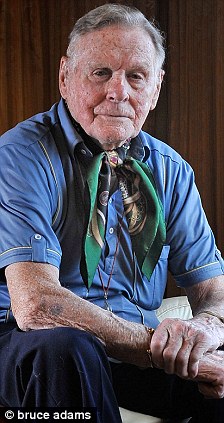
Simons also tells us that Avey has a glass eye.
I ask him about it. He tells me that in 1944, he cursed an SS officer who was beating a Jew in the camp. He received a blow with a pistol butt and his eye was knocked in.
This is unlikely because the SS guards were under strict rules forbidding the beating of prisoners, let alone a British Prisoner of War who was under the authority of the Wehrmacht. The guard would have been severely punished, possibly even given a death sentence. Do Avey’s records say he was then hospitalized and had his eye removed? You can be sure there aren’t any such records.
Avey grew up on an Essex farm, describing himself as living a rough-and-tumble lifestyle. “I had a shock of red hair and a temperament to match.” In 1939 he volunteered for the Army—because he was too impatient to wait a week for the RAF (my emphasis). “I ended up in the 7th Armoured Division, the original Desert Rats,” he says. “We operated behind enemy lines in Egypt. In 1942 we were ambushed. I was wounded and taken prisoner by the Germans.”
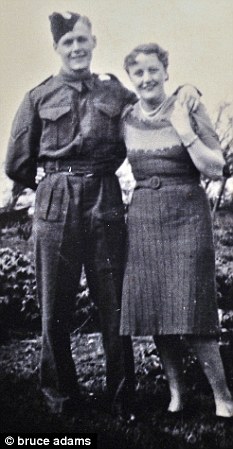
For all his bravery, Avey told The Mail reporter, Andy Dolan, the reason he took so long to speak about his experience was “because I was so traumatised at my whole experience of the Auschwitz camps it took me 60 years to be able to recount the horrors I saw.”(5) We will see that Avey’s experience of the regular Auschwitz camps consisted of two nights supposedly spent in an Auschwitz barracks.
Avey at Auschwitz
The Times article continues:
Avey was a troublesome prisoner. In the summer of 1943 he was deported to Auschwitz, in Poland, and interned in a small PoW camp on the periphery of the IG Farben factory. The main Jewish camps were several miles to the west. I’d lost my liberty, but none of my spirit, he says. I was still determined to give as good as I got.
By main Jewish camps, Simons means Auschwitz (I) and Birkenau (Auschwitz II). The main Jewish camp by the IG Farben plant was named Monowitz (Auschwitz III). The British POW camp was near the construction site of the Farben Buna plant and several hundred meters west of the Monowitz workers’ camp. The first 200 British POWs arrived in September 1943. The barracks for the Monowitz camp were built in 1942 and all the prisoners who worked at the Farben industrial complex were moved into them. No Farben workers remained housed at Auschwitz or Birkenau after that.
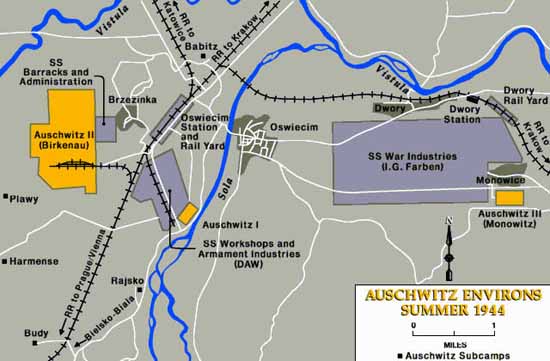
Avey says he immediately knew the situation at Monowitz:
The Stripeys — that’s what we called the Jewish prisoners — were in a terrible state. Within months they were reduced to waifs and then they disappeared. The stench from the crematoria was appalling, civilians from as far away as Katowice were complaining. Everybody knew what was going on. Everybody knew.
The POW camp was separate from the Jewish camp and administered by the Wehrmacht, not the SS, so how does he know what state they were in? The Poles from the area say they did not know what was going on. The part about the stench cannot be true; nowhere is it said there were crematoria in Monowitz, and it is at least 10 km from Birkenau where the crematoria were. The city of Katowice is approximately 50 km away, and is a highly industrialized area that could be considered to have polluted air. Same with the Buna synthetic rubber plant—some odors would probably have come from there.
Remarkably, for a hothead, Avey was able to think beyond the war.
I knew in my gut that these swine would eventually be held to account. Evidence would be vital. Of course, sneaking into the Jewish camp was a ludicrous idea. It was like breaking into Hell. But that’s the sort of chap I was. Reckless.
Simons tells us that
Avey’s audacious plan was made possible by Ernst Lobethall, a German Jew from Breslau, who worked alongside Avey at the Farben factory. Although fraternising was forbidden on pain of death, the two men became friends. We spoke out of the corner of our mouths, Avey says, a difficult thing to do in German.
Avey’s plan was made possible by Lobethal? How so? Lobethal says nothing about Ginger trading places with a Jewish prisoner in his testimony; he only spoke of getting cigarettes. It’s Avey who’s filled in all the rest. And did POW’s and Jewish prisoners work together? Sometimes, no doubt, but it’s rare to hear about it. If fraternizing was forbidden on pain of death, what would compel them to take the chance? And when did Avey learn to speak German, growing up on a farm in Essex and clearly disliking Germans, whom he called swine?
Lobethal revealed to Avey he had a sister living in England, so Avey says he
wrote to my mother, who told Susana that Ernst was alive. She posted 200 cigarettes to me via the Red Cross. Miraculously, four months later, they arrived. The cigarettes were worth a king’s ransom. Ernst suddenly became rich.
The problem here is that if Lobethal knows his sister’s address in England, he could have written to her himself. She could have sent a package with cigarettes and chocolate directly to her brother and the Red Cross would have delivered it. Dennis Avey is superfluous in this instance. This is Giveaway No. 1 that the story is fake. The BBC article even tells us that Avey contacted his mother with a coded letter. Why? There was nothing he was saying that was against the rules, except that he was fraternizing with an inmate from the labor camp. Maybe careful wording is what he meant by coding.
Avey’s meticulous plan turns out to be this: (He) found a Dutch Jew with a similar physique and persuaded him to exchange places for a day. Avey knew that they marched past each other at the same time every week. “The Nazis were rigid, you see,” he says. “To them orders were orders, to be carried out exactly. That was what allowed me to find a way round them.”
Once again, in spite of the Nazis’ rigidity, he manages to persuade a Jew to risk his life in order to get one night outside his own barracks. The BBC article said:
He arranged to swap for one night at a time with a Jewish inmate he had come to trust.
Who was this inmate? It doesn’t say. The article in the Daily Mail says the inmate was Lobethal:
The pair met while being used as slave labour at a nearby synthetic rubber factory. At the end of their shift one night, Mr Avey changed into Mr Lobethall’s stripy uniform, took his ID card and returned with the Jewish prisoners to Birkenau, also known as Auschwitz II.(6)
Apart from Lobethal never saying anything in his ‘Survivors of the Shoah’ video testimony about trading places with Denis Avey, or going into the British POW camp, the prisoners did not carry ID cards. That’s what the tattoos were for, to keep track of them. Where did Andy Dolan get such an idea?
The Times continues:
Avey shaved his head and blackened his face. At the allocated time, he and the Dutch Jew sneaked into a disused shed. There they swapped uniforms and exchanged places. Avey affected a slouch and a cough, so that his English accent would be disguised should he be required to speak.
Try to imagine this if you can. The POWs and the Jewish prisoners are marching in different directions and pass each other. Time stops; everyone else goes into suspended animation while the two men leave the ranks and go into a shed nearby. They change into each other’s uniforms and return to take each other’s place in the ranks. Time resumes and so does the marching.
In addition to this, the British Prisoner of War has shaved his head, while the Jew with a shaved head is pretending to be a British Prisoner of War. And the rigid, order-bound SS guards don’t notice anything wrong. This is Giveaway No. 2.
Avey then tells Simons:
I joined the Stripeys and marched into Monowitz, a predominantly Jewish camp. As we passed beneath the Arbeit Macht Frei sign, everyone stood up straight and tried to look as healthy as they could. There was an SS officer there, weeding out the weaklings for the gas. Overhead was a gallows, which had a corpse hanging from it, as a deterrent. An orchestra was playing Wagner to accompany our march. It was chilling.
Avey is really warming up to his subject now. But he doesn’t know Monowitz from Auschwitz where the Arbeit Macht Frei sign is. Auschwitz had very few Jews in it; they were all at Birkenau and Monowitz. Giveaway No. 3.
The BBC article said:
He fully intended to get as far as Birkenau, where the gas chambers and crematoria were constantly in operation, belching acrid fumes. He only made it as far as Auschwitz III, (Monowitz) where he spent the night on two occasions.
So where was he? Since he doesn’t know, we can conclude he was never in these places. Especially when he describes it this way:
They were herded through the camp, carrying the bodies of those who had died that day. I saw the Frauenhaus—the Germans’ brothel of Jewish girls—and the infirmary, which sent its patients to the gas after two weeks. I committed everything to memory. We were lined up in the Appellplatz for a roll call, which lasted almost two hours. Then we were given some rotten cabbage soup and went to sleep in lice-infested bunks, three to a bed.
Here he is definitely describing Auschwitz I, 7 km from Monowitz where they worked. But he’s incorrect in everything he says. The brothel was called Die Puff, and didn’t have Jewish girls working in it, but Polish women from outside the camp. Jews could not use the brothel at all, following the Nuremberg laws of racial purity. The infirmaries would not care for patients for two weeks only to then send them to the gas chamber. The camp administration was constantly fighting lice in the barracks and on the inmates. That’s what the Zyklon B was for.
I wonder what happened in the British POW camp when the Dutch Jew brought his lice-infested body (according to Avey) into it and spent the night?! What about when Avey returned there after spending the night in a lice-infested bed? Here’s Avey’s description of the night:
The night was even worse than the daytime. As it grew dark, the place was filled with howls and shrieks. Many people had lost their minds. It was a living hell. Everyone was clutching their wooden bowls under their heads, to stop them getting stolen.
Only enamel covered metal bowls were used at all camps, so Avey reveals he’s making it up when he specifies wooden bowls. He also doesn’t tell us which barracks he stayed in. Giveaway No. 4.
Lobethall had bribed Avey’s bedfellows with cigarettes. They gave me all the details, he says, the names of the SS, the gas chambers, the crematoria, everything. After that, they fell asleep. But I lay awake all night.
Where is Lobethal? If Avey traded places with the Dutch Jew, can we assume he spent the night in Lobethal’s barracks? Again, I repeat that Lobethal didn’t mention anything about his friend Avey’s prisoner exchange in his testimony. If he bribed Avey’s bedfellows with cigarettes, he was a part of it. But why would suffering Jewish prisoners need to be bribed to talk about their sufferings? They wanted to get the information out to the rest of the world, as I understand it. And what good were the names of the SS to Avey; has he ever reported any crimes by guards whose names he got that have resulted in action taken? Also, the alleged gas chamber had not operated in Auschwitz since 1942; now it was 1944. In spite of the shrieks and howls in this living hell, his bedfellows fell right to sleep. In the morning, after roll call and breakfast, they were marched back out of the camp.
When we passed the shed again, I slipped in to meet the Dutch Jew, he says. That was hair raising. Although I trusted him, I couldn’t be sure that he’d turn up. And if an SS officer had looked in the wrong direction at the wrong time, that would have been it.
Amazing how the SS cooperated with his plan.
The changeover went smoothly, and Avey returned to the PoW camp. The Dutch Jew perished, but I’m certain that this short reprieve prolonged his life by several weeks, he says. Whether that was a good thing, I don’t know.
Returned to his camp with his shaved head? How many of his fellow POW’s knew what he was up to? And how convenient that the nameless Dutch Jew died, so there is no one, including relatives, alive today to corroborate Avey’s story… or not. In these far-out holocaust tales, the essential characters always die early, and are usually nameless. Giveaway No. 5.
Here would be a good place to show you what the British POW’s at their camp at Monowitz looked like. This is a picture of their soccer team, wearing matching team sport shirts, looking healthy, well-treated, and on friendly terms with their benign-looking Wehrmacht guards.
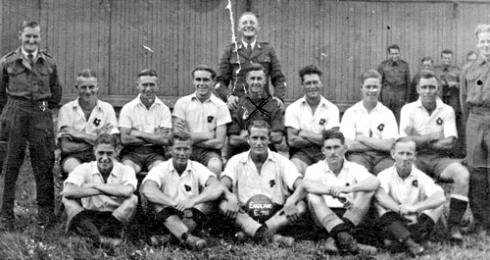
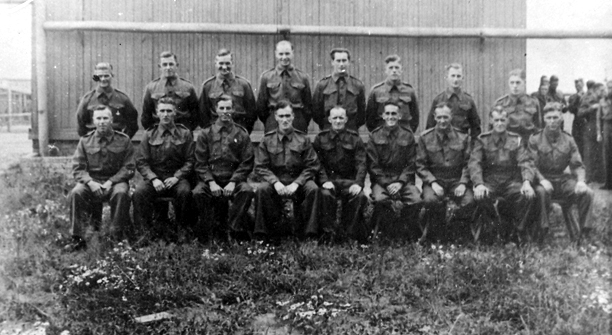
The Times article continues:
In 1945, as the Soviet Army closed in, the Nazis abandoned the camp and herded 60,000 prisoners in the direction of Germany, in what would become known as one of the Death Marches. Avey, who by then was suffering from tuberculosis, was among them. Around 15,000 prisoners died on the way. The road was littered with corpses, he says. I saw a chance to escape and seized it.
Giveaway No. 6. The POW’s didn’t go with the 60,000 regular prisoners. They didn’t leave until January 21, while the regular prisoners began their march on January 18. This is very important because it shows that Avey could not have been there if he didn’t know what kind of a march he was on. He’s saying things off the top of his head, depending on what he has read or heard. He knows about the death march of the 60,000 but not that the POW’s left later on a separate march.
He found his way to Allied lines and was transported back home. Two days before VE Day, he arrived at his parents’ Essex farm half-dead with exhaustion and sickness. They had not expected to see him again.
I think it’s certain the British or American Army would have hospitalized him right there if he had TB, not transported him sick and half-dead to his parents home, where he arrived on May 6. This arrival date to his parents in England may be documented, but Avey doesn’t say how long his March lasted or anything else about it. Again, this is typical of false stories. I would like to see the official military record for Mr. Avey!
Simons now reveals even he knows this story doesn’t make sense.
If Avey’s story still sounds implausible, there is no doubt about the help he gave to Lobethall. Last year the BBC screened a moving documentary, during which Avey learnt for the first time that his old friend had survived the war and died in New York in 2001. Before his death, Lobethall recorded a video testimony for Steven Spielberg’s Shoah Foundation, during which he emotionally recounts how his life was saved by Avey’s (actually Ginger’s – he never says he knew the soldier’s name) initiative and Susana’s cigarettes. This is the only moment that I see Avey’s steely façade falter.
In other words, if you can’t believe Avey, then at least believe Lobethall!
“I was hospitalised for two years after the war,” Avey continues. “In 1947, I went to the military authorities to submit my information about Auschwitz. Their eyes glazed over. I wasn’t taken seriously. I was shocked, especially after the risks I’d taken. I felt completely disillusioned, and traumatised as well. So from then on I bottled it up, and tried to piece my life back together.”
This may just be his way of explaining why he waited 65 years to speak of this—until Yad Vashem and the BBC came looking for a red-haired British POW.
Readjusting to normal life was hard. Avey became addicted to adrenalin, racing fast cars, travelling to Spain for the running of the bulls. He was plagued by nightmares and flashbacks. Even today he shows signs of trauma. He always carries an expensive gold watch, so that “if ever I find myself in a fix again, I’ve got something to fall back on.”
Two nights spent in an Auschwitz barracks (considering that it really happened) would not create such Post Traumatic Stress in a tough, ready-for-anything Desert Rat, as he describes himself. This is Giveaway No. 7. Avey is clearly a man who has always had a myriad of psychological problems. His reckless nature leads him to take advantage of this opportunity for a claim to fame as a ‘Righteous Among the Nations.’ But what does it say about Yad Vashem that they appear to be on the verge of accepting Avey’s preposterous account? Why is Yad Vashem so anxious to confer this designation upon as many Gentiles as possible?
How Yad Vashem Gains from their Righteous Program
Let’s look further into the meaning of this honor bestowed by Jews upon Gentiles. Yad Vashem says:
Each case must be substantiated by eyewitness testimonies and archival documents of the period. Signed and notarized testimonies by survivor and other witnesses of the rescue attempt. Testimonies should include all known personal data on rescuers and survivors, a detailed account of the rescue attempt (how the contact with the rescuer was made; the form of rescue; places and dates of rescue; what arrangements or agreements were made between rescuers and survivors; how did the danger to the rescuers manifest itself; any other details that may shed light on the nature of rescue.) (7)
Where are the testimonies for Avey and Lobethal? They come only from Avey, Lobethall and Lobethall’s sister, a rather ingrown group. There are no outside neutral parties. The BBC tells us that Avey briefly met Susana Lobethal in 1945, when he came home from the war, traumatized by what he’d witnessed and endured. They both thought Ernst was dead. But where are the witnesses to this meeting? Susana lost touch with Avey and thus never told him the good news when she found out Ernst was alive.
Is it because all Avey did was to smuggle cigarettes to Lobethal (according to Lobethal) that they needed to build up a grander picture of him as risking his life? Yad Vashem and the British news media go to great lengths always to keep the horror of Auschwitz alive in the public consciousness. Denis Avey serves this purpose for them, in spite of the unbelievable nature of his story. As we can see from the comments from readers to these three newspaper articles, they accept what he says without question.
As for Yad Vashem, they have an even more sinister purpose for their ‘Righteous Among the Nations’ than just pushing holocaust horror stories. This program has created for Israel a moral high-ground for Jews, from whence they look down upon and reward Gentiles who have put their own lives in danger to save Jews. This is a subtle, or not so subtle, statement that good Gentiles defend and protect Jews. Do they ever say it is the responsibility of Jews to protect Gentiles? Never—this is never brought up at all. Because in their Jewish universe, Gentiles can only be perpetrators or silent bystanders, while Jews are perpetual victims of Gentiles. No matter what kind of murderous behavior Jews exhibit, this storyline never changes.
Elie Wiesel, that personification of everything that is wrong with the holocaust industry, speaking at the 2005 opening of the new Yad Vashem Museum in Jerusalem, made this statement:
The Holocaust was not man’s inhumanity to man. It was man’s inhumanity to the Jews. (8)
This sums up the ethnocentric view of world Judaism, of religious Judaism and Zionism both—it’s all about us, and we are working to make that the legal framework of this planet. Watch out, Gentiles!
It’s instructive to look at the situation of the Roman Catholic Church and the path to sainthood of one of their beloved Popes, Pius XII. Jewry is doing everything in its power to stop the canonization of Pius XII because, in their estimation, he didn’t do enough to help the Jews during their holocaust. Therefore, in their eyes he is not Righteous. Wrongly, they make it his responsibility, not their own, to look out for Jews. This is the message that’s being transferred to the rest of us by constant barrage of Jewish outrage and interference in Gentile affairs. While some of us can see through it, most cannot.
But what if the tables were turned and concerned Gentiles were to do everything in their power to stop the ‘Righteous Among the Nations’ from being conferred on Denis Avey, on the basis that he is unworthy of it? He is certainly lying about his exploits back in the camps; what was his status there exactly? The Jews are demanding all documents relating to Pius XII during the war years be released to them; we should likewise demand to see Denis Avey’s military records, at the very least. We should make it our business, just as they make the Church’s sainthood process their business.
In closing, I’d like to quote from a recent article (9) by Steven Walt (co-author, The Israel Lobby and U.S. Foreign Policy).
Challenging Orthodoxy Is a Form of ‘Asymmetric Conflict’: You Win By ‘Not Losing.’ As long as you remain part of the debate, you’re winning. Minds don’t change overnight, and it is difficult to know how well an intellectual campaign is going at any particular point in time—some days you might think you’re winning big, while other days the deck will appear to be stacked against you. But the real question is: are you still in the game?
Endnotes
-
http://www1.yadvashem.org/righteous_new/about_the_program.html
-
Ibid: news.bbc.co.uk. The BBC has now reunited the pair after tracing Susana, who is now Susana Timms and lives in the Midlands.
-
http://women.timesonline.co.uk/tol/life_and_style/women/the_way_we_live/article7039572.ece
-
Ibid.
-
http://walt.foreignpolicy.com/posts/2010/02/22/on_grabbing_the_third_rail
Bibliographic information about this document: Originally published at https://carolynyeager.net/denis-avey-man-who-would-be-righteous
Other contributors to this document:
Editor’s comments:
